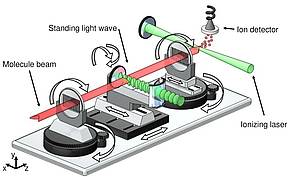From matter waves to precise quantum nanopatterns
In physics, matter may behave both like a quantum wave and like a classical particle. This duality lies at the heart of physics and is the basis for many quantum technologies with electrons, neutrons, atoms or molecules.
The most recent contribution by the Vienna group around Markus Arndt now demonstrates for the first time the use of that principle for precise quantum interference lithography with molecules: When molecules traverse an arrangement of two gratings, their quantum wave behavior leads to the formation of nanostructured fringes – with fringe periods of about 250 nm – which can be captured on a surface.
Thomas Juffmann, Stefan Truppe and their colleagues have now been able to fix and image both the particle and the wave nature of individual molecules in one and the same image (Figure 1): The molecules are imaged as particles that are localized with atomic resolution on the surface. Scanning tunneling microscopy even gives a glimpse on their internal structure. But the distribution of the molecular ensemble across the surface can only be explained assuming that each molecule had been delocalized over several hundred times its own diameter while flying through the apparatus.
Single molecules represent the smallest functional units in many emerging technologies. Quantum interference lithography allows positioning them on surfaces in a non-contact and therefore non-invasive way. Quantum diffraction actually increases the fringe contrast significantly over classical beam patterning methods for large molecules.
Following the successful proof-of-principle experiment in Vienna future research will now focus on generating smaller, sharper and more versatile two-dimensional quantum nanopatterns.
This work was done jointly with the former group Vienna member, Dr. Hendrik Ulbricht, who has meanwhile started an independent research group and operates as an ESF associate partner in MIME at the University of Southampton, UK.
View publication in Physical Review Letters ...
Vienna group (ESF MIME Coordinator):
Contact:
Prof. Markus Arndt: Markus.Arndt[at]univie.ac.at
Thomas Juffmann: Thomas.Juffmann[at]univie.ac.at
Web:
http://www.quantum.at/research/molecule-interferometry-foundations.html
Southampton group (ESF MIME Associate Partner):
Contact:
Dr. Hendrik Ulbricht, h.ulbricht[at]soton.ac.uk
Web:
http://www.phys.soton.ac.uk/matterwave/html/index.html
Pushing the limits of matter wave interferometry
 |
Research on matter waves is a thriving field of quantum physics, currently pursued by many research groups around the world both for elucidating questions on the foundations of quantum physics and for developing new methods for precision measurements. Researchers of EuroQUASAR-MIME are currently holding the world record in what concerns particle mass, molecular chain length and complexity for matter wave interferometry. The increased molecular complexity is associated with more possibilities to couple the quantum system, i.e. the molecule, to its environment. This offers new handles for studying decoherence, i.e. the apparent loss of quantumness, in new ways: Molecules may be internally as hot as fire, while still showing full quantum behavior in their center of mass motion. Moreover, even at equal mass, two molecules may have a different internal conformation, chemical structure, handedness, temperature, electric or magnetic moment.
The researchers are able to experimentally identify the role played in de Broglie interferometry by the internal structure and dynamics of the quantum object. Any machine designed to measure wavelength differences of massive matter, is intrinsically well-adapted for metrology. In experiments by EuroQUASAR-MIME, matter wavelengths as small as one picometer can be easily handled and lateral shifts of nanometer-sized interference patterns can still be measured.
This turns molecule interferometry into an interesting tool for determining the molecular properties, that may appear as ‘decohering agents’ in other quantum experiments. Interferometric molecule metrology will deliver new data for future quantum experiments but its generated information is valuable for computational and experimental chemistry. The recent achievements include demonstration of molecular matter wave metrology as a tool for distinguishing different molecular fragmentation pathways (Angew. Chemie 2008), demonstration of quantum interference in precise measurement of the molecular optical polarizability (New J. Phys. 2009), exploration of molecule interferometry for the sensitive and absolute measurement of the absolute absorption cross section of large molecules (Phys. Rev. A 2008), and the identification of the role of thermally activated molecular dipole moments for matter wave interferometry (in prep.).

